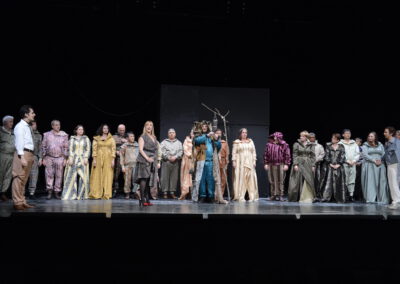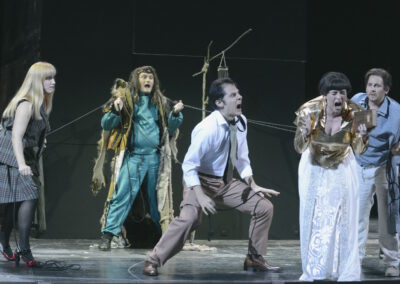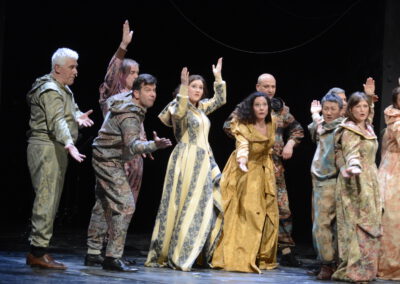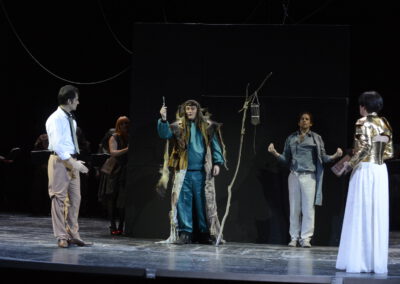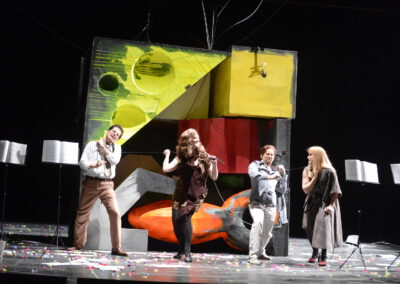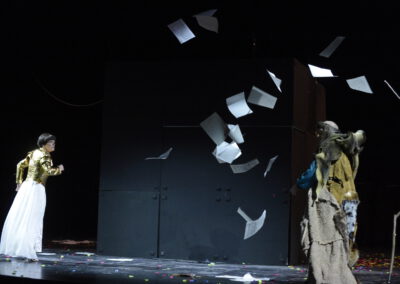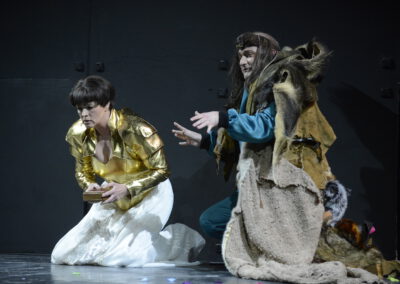ORLANDO. DAS SCHLOSS (2012/2013)
ORLANDO. DAS SCHLOSS (2012/2013)
Opera in one act for six voices, mixed choir, electronics and orchestra
Libretto by Alexander Stockinger
orchestra: 3*.2*.3*.2*/4.3.2.1/ 2perc/arp*/pno/cel/cemb*/7.6.5.4.3
vocal soloists: 2S/A/T/Br/B
choir: SSATB
duration: 35 minutes
première: June 15, 2013, Theater Bielefeld, Germany
Conducted by Aurelien Bello
Project in cooperation with Akademie Musiktheater heute der Deutsche Bank Stiftung
Commissioned by Deutsche Bank Stiftung and Theater Bielefeld
ORLANDO. DAS SCHLOSS
score preview
ORLANDO. DAS SCHLOSS
(excerpt)
June 13, 2013 (dress rehearsal)
Theater Bielefeld, conducted by Aurelien Bello
Additional performances
VIDEO
Theater Bielefeld
Conducted by Aurelien Bello
Theater Bielefeld, conducted by Aurelien Bello
ABOUT
Composed as part of a triptych of operas by different composers to celebrate the 2010 – 2012 edition of Deutsche Bank’s Akademie Musiktheater heute (Academy of Contemporary Music Theatre), ORLANDO. DAS SCHLOSS (“Orlando: the Castle”) is a criticism of consumerism and celebrity culture. Orlando, a shallow and materialistic lady from renaissance-period aristocracy, reflects on her place as a literary figure in today’s world and comes up against Karl, the modern emperor, personification of consumerism, media spectacle and self-gratification.
The music to ORLANDO. DAS SCHLOSS is highly colourful. The vocal elements, consisting of the two main figures (Orlando, a soprano; Karl, a bass), as well a four-part solo chorus (each member doubling in minor solo roles) and a more conventional 10-voice chorus, are complemented by an orchestra with triple winds, a string section of chamber-orchestral dimensions, two percussionists and a veritable smorgasbord of keyboards. All of this is rounded off with the judicious application of electronic elements.
The relationships between the staged and vocal drama and the more abstract musical elements is colourful and complex, reflecting the relationships within the music itself. On one level, Žuraj sets great store on clarity of delivery in the text, and does not indulge in textual and phonetic deconstruction to turn the libretto into pure music. On the other hand, the libretto already contains abstract and fantastical phonetic elements (presented by the choruses) that have a musical life independent of dialogue and drama.
In addition to the dramatic and purely musical aspects within the vocal parts, the two protagonists play percussion instruments. Karl plays a spring drum, Orlando a microtonal kalimba, thus creating a bridge between the staged elements of the work in the workings of the orchestra. All of the techniques employed by Žuraj in the years leading up to Orlando are on full display. Shimmering, microtonal harmonies are distributed across the orchestra in rhythmic constellations that see the orchestra function as a single instrument which can diverge into multiple ensembles or groups of soloists and back again seamlessly. Just as the vocal and instrumental elements are linked by placing instruments in the hands of the singers, the keyboard and percussion are integrated into the ranks of the melody instruments (especially the strings) by Žuraj’s distinctive use of microtonal kalimba, cimbalo cromatico and clavichord (both tuned in quarter-tones), and a harp tuned a quarter-tone flatter than the piano. Naturally, all of this is assembled according to Žuraj’s mix of algorithmic and spontaneous compositional methods.
Alwyn Tomas Westbrooke
Composed as part of a triptych of operas by different composers to celebrate the 2010 – 2012 edition of Deutsche Bank’s Akademie Musiktheater heute (Academy of Contemporary Music Theatre), ORLANDO. DAS SCHLOSS (ORLANDO. THE CASTLE) is a criticism of consumerism and celebrity culture. Orlando, a shallow and materialistic lady from renaissance-period aristocracy, reflects on her place as a literary figure in today’s world and comes up against Karl, the modern emperor, personification of consumerism, media spectacle and self-gratification.
The music to ORLANDO. DAS SCHLOSS is highly colourful. The vocal elements, consisting of the two main figures (Orlando, a soprano; Karl, a bass), as well a four-part solo chorus (each member doubling in minor solo roles) and a more conventional 10-voice chorus, are complemented by an orchestra with triple winds, a string section of chamber-orchestral dimensions, two percussionists and a veritable smorgasbord of keyboards. All of this is rounded off with the judicious application of electronic elements.
The relationships between the staged and vocal drama and the more abstract musical elements is colourful and complex, reflecting the relationships within the music itself. On one level, Žuraj sets great store on clarity of delivery in the text, and does not indulge in textual and phonetic deconstruction to turn the libretto into pure music. On the other hand, the libretto already contains abstract and fantastical phonetic elements (presented by the choruses) that have a musical life independent of dialogue and drama.
In addition to the dramatic and purely musical aspects within the vocal parts, the two protagonists play percussion instruments. Karl plays a spring drum, Orlando a microtonal kalimba, thus creating a bridge between the staged elements of the work in the workings of the orchestra. All of the techniques employed by Žuraj in the years leading up to Orlando are on full display. Shimmering, microtonal harmonies are distributed across the orchestra in rhythmic constellations that see the orchestra function as a single instrument which can diverge into multiple ensembles or groups of soloists and back again seamlessly. Just as the vocal and instrumental elements are linked by placing instruments in the hands of the singers, the keyboard and percussion are integrated into the ranks of the melody instruments (especially the strings) by Žuraj’s distinctive use of microtonal kalimba, cimbalo cromatico and clavichord (both tuned in quarter-tones), and a harp tuned a quarter-tone flatter than the piano. Naturally, all of this is assembled according to Žuraj’s mix of algorithmic and spontaneous compositional methods.
Alwyn Tomas Westbrooke

